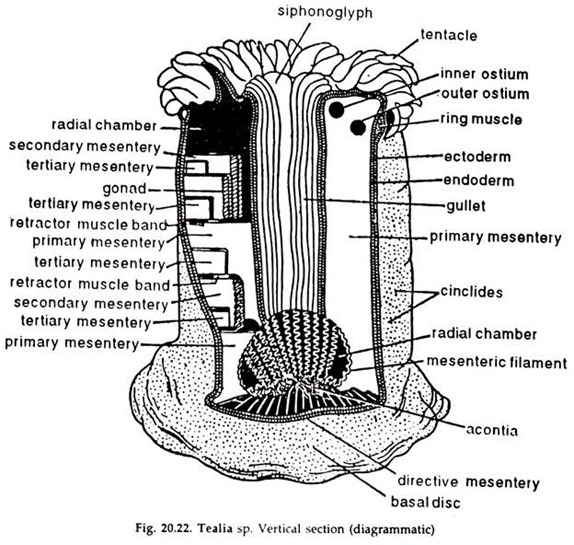In this article we will discuss about the body form and body wall of sea anemone, explained with the help of a suitable diagram.
Body Form and Mesentery of Sea Anemone:
1. Column-like body, broader than high.
2. At the anterior end lies the oral disc.
ADVERTISEMENTS:
3. In the middle of the oral disc lies the mouth.
4. From the edges of the oral disc are given off a number of short conical tentacles, arranged in five rings.
5. Outermost whorl carries the maximum number of tentacles, which is forty-eight. The subsequent whorls bear successively lesser number of tentacles.
6. The posterior region of the body is flattened to form a basal disc for the purpose of attachment.
ADVERTISEMENTS:
7. The oral disc invaginates to form a gullet or food tube, suspended into the general cavity.
8. The gullet has on its either side a pair of smooth, heavily ciliated furrows placed one at each end of the long diameter, through which the water passes to the enteron, the siphonoglyph.
9. The general cavity is subdivided into radial compartments by six distinct septa, each of which extends from the wall to the gullet. The septa are complete and known as primary mesenteries.
10. In between the primary mesenteries, two types of incomplete partition walls are found to be inserted; some are larger than the other. The larger partition wall is known as secondary mesentery and the smaller as the tertiary mesentery. Thus the gastro vascular cavity is subdivided into a number of vertical chambers by projecting partitions.
ADVERTISEMENTS:
11. Each septum has a pair of Ostia beneath the oral disc, for direct communication of the inter-mesenteric compartments.
12. The thick free inner margin of the septum convolutes to from mesenteric filament, and continues posteriorly as threadlike acontium. Acontium protrudes either through the mouth or through cinclides (openings in the body wall) for subduing prey.
Body Wall of Sea Anemone:
1. The epidermis and gastro dermis are separated by a very thick and tough layer of mesogloea. The former two consist mainly of very long, columnar, ciliated epitheliomuscular cells. The mesogloea, being traversed by a network of delicate fibres with interspersed cells, has assumed the characteristics of an intermediate cell layer.
2. Stinging capsules occur in the epidermis, and are also abundant in the mesenteric filaments.
3. Gland cells are abundant in the epidermal lining of the gullet and in the mesenteric filaments.
4. Each septum has got three sets of muscles, retractor (vertical), transverse (across) and parietal (oblique).
5. Nerve net occurs both in ectoderm and endoderm.
6. The gonads are endodermal in origin and the sexes are separate.
7. Development with complicated metamorphosis and planula stage.
